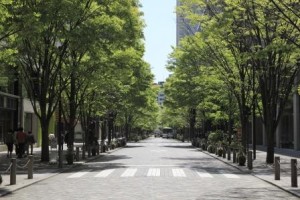 By the time we reach adulthood, most Americans have come to understand that money doesn't grow on trees. But a new study published in PLOS ONE this month shows that trees do – figuratively speaking – grow on money.
Christopher Boone, dean of the School of Sustainability at Arizona State University, was among the authors of the study. The article resulted from a workshop led by Boone at the National Center for Ecological Analysis and Synthesis.
"We studied seven cities across the U.S.," says Boone. "What we found was a correlation between low-income neighborhoods and low-density tree cover."
Basically, the lower the income at the census-tract level, the lower (on average) the tree cover. Wealthy neighborhoods, meanwhile, are more likely to have more and denser trees.
Trees have real benefits in neighborhoods, including reducing the urban heat island by providing shade. But trees also require care, especially in drier locations where water is often more expensive. And when the burden of tree care is passed on to those who cannot afford it, or if trees consume scarce water supplies or increase allergens in a community, planting them might bring more harm than good.
The authors conclude that increased tree cover is a valuable piece of urban sustainability plans, both in terms of social justice and climate mitigation. Based on their findings, equitable – yet thoughtful – distribution of trees should be a goal.
By the time we reach adulthood, most Americans have come to understand that money doesn't grow on trees. But a new study published in PLOS ONE this month shows that trees do – figuratively speaking – grow on money.
Christopher Boone, dean of the School of Sustainability at Arizona State University, was among the authors of the study. The article resulted from a workshop led by Boone at the National Center for Ecological Analysis and Synthesis.
"We studied seven cities across the U.S.," says Boone. "What we found was a correlation between low-income neighborhoods and low-density tree cover."
Basically, the lower the income at the census-tract level, the lower (on average) the tree cover. Wealthy neighborhoods, meanwhile, are more likely to have more and denser trees.
Trees have real benefits in neighborhoods, including reducing the urban heat island by providing shade. But trees also require care, especially in drier locations where water is often more expensive. And when the burden of tree care is passed on to those who cannot afford it, or if trees consume scarce water supplies or increase allergens in a community, planting them might bring more harm than good.
The authors conclude that increased tree cover is a valuable piece of urban sustainability plans, both in terms of social justice and climate mitigation. Based on their findings, equitable – yet thoughtful – distribution of trees should be a goal.New finding: trees grow on money
 By the time we reach adulthood, most Americans have come to understand that money doesn't grow on trees. But a new study published in PLOS ONE this month shows that trees do – figuratively speaking – grow on money.
Christopher Boone, dean of the School of Sustainability at Arizona State University, was among the authors of the study. The article resulted from a workshop led by Boone at the National Center for Ecological Analysis and Synthesis.
"We studied seven cities across the U.S.," says Boone. "What we found was a correlation between low-income neighborhoods and low-density tree cover."
Basically, the lower the income at the census-tract level, the lower (on average) the tree cover. Wealthy neighborhoods, meanwhile, are more likely to have more and denser trees.
Trees have real benefits in neighborhoods, including reducing the urban heat island by providing shade. But trees also require care, especially in drier locations where water is often more expensive. And when the burden of tree care is passed on to those who cannot afford it, or if trees consume scarce water supplies or increase allergens in a community, planting them might bring more harm than good.
The authors conclude that increased tree cover is a valuable piece of urban sustainability plans, both in terms of social justice and climate mitigation. Based on their findings, equitable – yet thoughtful – distribution of trees should be a goal.
By the time we reach adulthood, most Americans have come to understand that money doesn't grow on trees. But a new study published in PLOS ONE this month shows that trees do – figuratively speaking – grow on money.
Christopher Boone, dean of the School of Sustainability at Arizona State University, was among the authors of the study. The article resulted from a workshop led by Boone at the National Center for Ecological Analysis and Synthesis.
"We studied seven cities across the U.S.," says Boone. "What we found was a correlation between low-income neighborhoods and low-density tree cover."
Basically, the lower the income at the census-tract level, the lower (on average) the tree cover. Wealthy neighborhoods, meanwhile, are more likely to have more and denser trees.
Trees have real benefits in neighborhoods, including reducing the urban heat island by providing shade. But trees also require care, especially in drier locations where water is often more expensive. And when the burden of tree care is passed on to those who cannot afford it, or if trees consume scarce water supplies or increase allergens in a community, planting them might bring more harm than good.
The authors conclude that increased tree cover is a valuable piece of urban sustainability plans, both in terms of social justice and climate mitigation. Based on their findings, equitable – yet thoughtful – distribution of trees should be a goal.